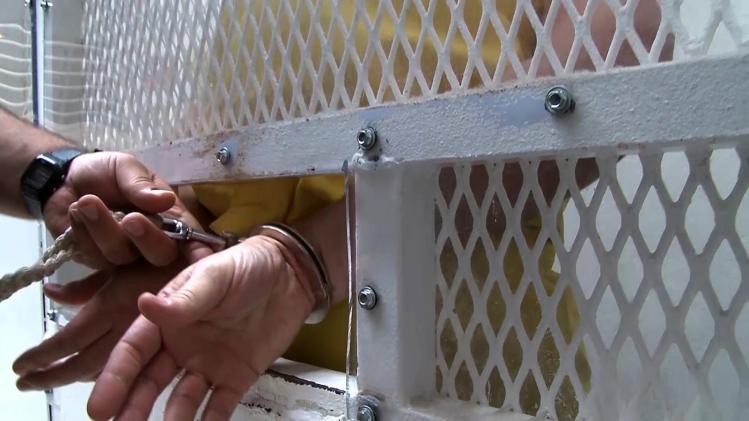
The coronavirus has devastated the American penal system, with close to four hundred thousand inmates contracting the disease. Desperate to control the spread, jails and prisons have increased their use of solitary confinement, resulting in a nearly 500-percent increase in the number of people held there between February and June 2020. This is a troubling development: though we have long understood the ways in which solitary confinement damages human beings physically, psychologically, and spiritually, sick inmates are nevertheless now regularly housed in isolation units designed for punitive, rather than curative, purposes.
It’s therefore timely that Christine Montross, a clinical psychiatrist with years of experience working in jails and prisons, has published a book on mental illness in the U.S. penal system. Montross writes compassionately and compellingly, correctly indicting our penal system for its failures. Yet her analysis also falls short in significant ways: she often ignores past and present abuses carried out by psychiatry and psychology, and too readily reduces complex philosophical questions to simple biological causes.
Anyone who works or volunteers in jails or prisons quickly realizes just how widespread mental illness is within these institutions. Montross estimates that at least 356,000 U.S. inmates suffer from serious mental illnesses (which include schizophrenia, clinical depression, and bipolar disorder). Through the voices of former patients (masked by pseudonyms), she explores different facets of this terrible problem. In doing so, she conveys her respect for the personhood of individual inmates, as well as her conviction that jails and prisons are hardly the appropriate place for them. Montross’s chapter on the Cook County Jail in Chicago (where I’ve also conducted research) is particularly gripping: she captures well the fear that afflicts both inmates and employees. And her portrait is nuanced, pointing out how Cook County Sheriff Thomas Dart and his staff have worked to alleviate the suffering of incarcerated people with mental illness.
But the conscientiousness of some staff often conflicts with the coercive intent of prison design. Montross’s discussion of the architecture of supermax prisons (built to isolate inmates in solitary confinement) is particularly sobering. Since the nineteenth century, architects have designed prisons in order to inflict maximum suffering on inmates. The planners of today’s supermax prisons share this disturbing aspiration, as the architect of the Northern Supermax Prison in Connecticut proudly tells Montross. True, Montross balances such repulsive figures with more attractive ones, like Gerard Gagné, a psychiatrist who compassionately aids prisoners confined at Northern. But her assessment of the draconian sentencing and incarceration policies that prevail in the United States is unflinching: they’re rooted in fear and the desire to eliminate risk at any cost. Montross concludes by recommending that U.S. jails and prisons adopt more lenient, rehabilitative penal practices modeled on those found in Norway and Sweden.
If Montross’s descriptions of the horrors of modern solitary confinement are accurate, she fails to adequately explain why today’s penal institutions are filled with so many inmates suffering from mental illness in the first place. She blames the current reality on the failures of twentieth-century deinstitutionalization, the long and complex process whereby the United States dismantled its large mental institutions. Without access to these institutions, the argument goes, would-be patients now end up in jails and prisons. But deinstitutionalization wasn’t uniformly bad. Montross makes only passing reference to the inhumane methods commonly used in mental institutions in the first half of the twentieth century before deinstitutionalization began: insulin-shock therapy, long periods of involuntary confinement, squalid conditions in state institutions, and widespread use of Thorazine and lobotomy. Deinstitutionalization wasn’t just about saving money; it also grew out of genuine concern for the civil rights and dignity of those living in mental institutions. Little of this history appears in Montross’s account, tempting us to minimize the role of psychiatry and psychology in creating today’s crisis.
Is the inhumane treatment so prevalent in correctional facilities today simply the result of good intentions gone wrong, as Montross seems to believe? By drawing attention to the elite class interests that desire to dominate “lower” elements of society, thinkers like Michael Foucault, Erving Goffman, David Rothman, and Andrew Scull have all taught us to be suspicious of the supposed good intentions of those who incarcerate others—including the intentions of psychiatrists and psychologists. Montross would have us believe that we might stop the abuses by simply separating the “mad from the bad,” offering the former treatment instead of punishment. That would be an improvement. I have met many compassionate people like Montross, and admire their dedication to helping inmates. But compassion is hardly the norm for those working in correctional or mental institutions. They may begin their careers with good intentions, but the inherent tension between the custodial and therapeutic aims of coercive institutions soon changes them. Prioritizing order over care, many quickly adopt cynical attitudes toward those they are supposed to heal.
This problem is compounded by the tendency of many psychiatrists to embrace a purely biological model of mental-health care. Too often for inmates, treatment consists of taking medication and occasionally seeing a psychiatrist who spends limited time in their facility. Other forms of therapy (if they are available at all) are left to mental-health counselors with varying degrees of commitment, education, and qualifications. The result is that inmates are dehumanized and not treated as people with complex inner lives. They’re simply pacified with medication. Montross says nothing about these familiar but troubling dynamics, failing to address the ways in which they might affect her proposals for change.
In fact, Montross herself is prone to fall back on biological models as she takes up complex philosophical issues. In her account of evil, for example, Montross reduces difficult matters of human motivation and free will to questions of brain functioning and group dynamics. This narrow focus on neurological or sociological language reflects larger trends in the human sciences. Scholars like Anne Harrington have carefully detailed the problematic character of today’s purely biological approach to mental illness. Montross would have done well to engage with such critiques, especially because she frequently muses on philosophical questions throughout the book.
Despite its limitations, this is a compelling study written by a clinician who recognizes the profound dysfunctions of our penal system. It is particularly relevant now, as those in prisons and jails are continuing to struggle with mental illness in the midst of the pandemic. I hope the book spurs serious conversations about mental illness in our society. Even better would be a greater commitment to helping people suffering in jails and prison. They desperately need it.
Waiting for an Echo
The Madness of American Incarceration
Christine Montross
Penguin Press
$28 | 352 pp.
Please email comments to [email protected] and join the conversation on our Facebook page.
Previous Story
‘Enough Bromides’
Next Story
Rogue State


